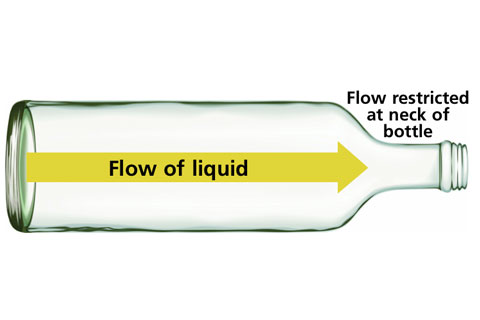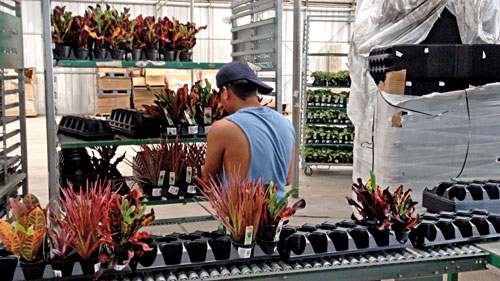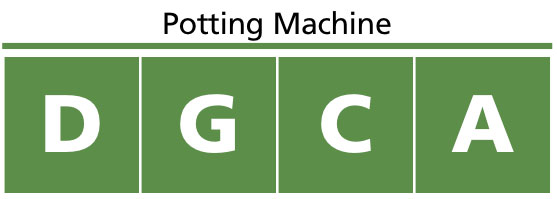5/1/2018
Uncorking the Bottlenecks
Gary Cortés
The term Lean Flow focuses on two main subjects: 1) LEAN out the waste (non-value-added work) and; 2) let the product FLOW.
In all of our implementations, we focus on improving productivity and efficiency. We accomplish this by reducing or eliminating waste as opposed to trying to reduce the value-added work content time. Much of this waste in the process becomes a bottleneck, which can drastically reduce productivity.
So why is it called a bottleneck? The picture below defines the name.
 The next thing you should do is identify where your bottlenecks exist and how to eliminate them. Here are some of the areas where we typically find bottlenecks, along with the means to uncork them.
The next thing you should do is identify where your bottlenecks exist and how to eliminate them. Here are some of the areas where we typically find bottlenecks, along with the means to uncork them.
Potting process
One of the most common bottlenecks that we see is in the potting process—not necessarily in the potting line itself, but rather the overall potting process.
If you ever stand and watch the potting line run, you’ll see that when it runs, it runs efficiently. So where in the process is the waste? It’s how frequently the machine stops and for how long it stops that drive the issues.
The problems that typically occur in potting are often found at the beginning and end of the lines where the bottlenecks are frequently created. How many times does the machine have to stop because there’s no plant material, pots or media to feed the line? How often do you see the line stop because there are no wagons or trailers available to off-load the planted material? The real issue here is balance, or lack thereof. Since the overall processes aren’t balanced, the machine must stop. When it does, it creates bottlenecks. So how do you resolve these kinds of
imbalances?
Inbound plant material
Ensuring that there’s enough material to keep the line running is one of the main Lean Flow principles. To reduce the starts and stops of the line, we must plan the feeder processes to be at least one job ahead of the potting line. That means that if the potting team is planting variety “A,” the next variety, the next container, the next tags, etc. need to be ready before “A” has been completed. We want these changeovers to be external to the process while the machine continues to run, as opposed to stopping the line while we wait for these changeovers to occur. This technique is what we call sequencing utilizing in-process kanbans (IPK; “kanban” is a Japanese term for a communication signal and inventory tool to balance an assembly line).
How do we plan the sequence, so we can minimize the changeovers (which cause the bottlenecks)? You first look at all the orders that you need to produce each day. You then sort them in such a way that requires the least amount of changeover time for the entire process.
For example, if you have different media and require a changeover to switch media, then you need to run all the items that use the same media within the same sequence before moving on to the items that use a different media. If changing a pot size requires a changeover, then you need to run all the items that use the same container size within the same sequence before switching to the next size. The sequence in which the products are run is based on the least amount of time to changeover to the next variety. You define the sequence by determining which products after “A” require less time to changeover. The things to consider are: potting mix, pot size, machine adjustment, etc.
The sequence below is an example of how we would stage the materials in front of the machine based on the least amount of changeovers. These sequences are defined at planning prior to running the line.
Each letter represents a specific variety. They don’t run in alphabetical order because they are within the same sequence; i.e., they use the same media, pot size, etc. In order to have the least amount of changeover, which takes time, you need to determine the best sequence.
Outbound wagons & trailers
We typically see another major bottleneck at the back end of the potting line. The issue here is that the line run rate isn’t balanced with the laydown process. The machine is running at a certain rate, but the people driving product to the field or greenhouses to lay the product down are working at a different rate.
Although this may sound counter-intuitive, we often say, “Slow the machine down and take people off the machine.” The machine only needs to run fast enough to keep up with the volume required and no faster. Just because the machine can run at a certain speed, doesn’t mean that you should run it at that speed.
Lean Flow is based on math—determine how many products you need to run, so you can calculate how many people you need on the line, driving product to the laydown area and laying the product down. By slowing the machine down and putting your resources (people) where they need to be (balancing), you’ll get more product potted since the machine isn’t starting and stopping all day long.
Shipping process
During shipping season, there’s no time to waste. Some growers have only eight to 12 weeks to ship up to 80% of their annual sales. Throw in bad weather and the window is reduced even more. So what bottlenecks should you look for in the shipping process?
Pulling
Are the pullers in the field keeping up with the people on the dock? We see too often dock employees waiting for the pullers to bring up plants, so they can finish assembling orders. This often happens because the pulling is done by order instead of a master pull.
To avoid this bottleneck, you need to balance out the processes just as described in potting. If you know the time it takes to do the work and the volume required, then you can calculate the number of pullers needed to balance out with the number of people on the loading dock. We see quite often that the pullers are also not balanced across the nursery or greenhouse. Based on the daily demand of what’s going to be shipped, there may be too many pullers in one zone/location and not enough in another zone/location. The number of pullers in each zone/location should be calculated daily since every day the demand in mix and volume changes.
Another way to resolve this bottleneck is to utilize the supermarket technique that FlowVision has successfully implemented across many growers. This concept helps alleviate some of the bottleneck issues by pulling half a day ahead of when the orders are going to be assembled. This eliminates the potential of waiting (bottleneck) for product to come up to the dock. The supermarket acts like a big kanban. Product pulled in the morning is assembled and loaded onto trucks in the afternoon. Product pulled in the afternoon is assembled and loaded onto trucks the following morning.
 Picking/shopping & processing
Picking/shopping & processing
Once the product has been pulled to the loading dock, it may then need to be processed (cleaned, tagged and labeled). Here too we see quite often product backing up (bottlenecking)—often the processing lines are waiting for material to tag. If they’re waiting for product, then it’s due to an imbalance with the upstream picking process. We need to ensure that all processes have the correct number of resources based on the days’ demand. We calculate those resources and then staff to the calculations.
Pictured: Racks of material are staged behind the packer, ensuring that they don’t stop working to get material.
Since the math cannot see daily anomalies and your employees aren’t robots, we also teach the employees to flex between the operations to correct imbalances as they occur. That requires cross-training, which in turn makes your employees a much more valuable asset.
On other occasions, the process is waiting for tags, labels or racks/pallets. Just as we addressed in the potting line, we need to make sure that the material is available when the product arrives.
Housekeeping & organization
One area that you may not think will create a bottleneck is your housekeeping and organization. How much time do you lose because you can’t find the pots/trays you need? Or when you do find it, how much stuff do you have to move around to get to the needed material? While this is going on, it’s quite possible that a team of employees is waiting and can’t work because of the missing material. “A place for everything and everything in its place” is a phrase we often use to help form good housekeeping practices.
Another housekeeping-related issue occurs when machines aren’t properly cleaned and maintained—they breakdown. This breakdown creates a major bottleneck in the system. When the machine is down, no product is flowing off of the line.
Pictured: Each letter represents a specific variety. They don’t run in alphabetical order because they are within the same sequence; i.e., they use the same media, pot size, etc. In order to have the least amount of changeover, which takes time, you need to determine the best sequence.
One of the ways to avoid these bottlenecks is with proper housekeeping and preventative maintenance (PM). By keeping the machine clean and performing regular PM on the machine, you’ll see fewer breakdowns, which will translate into more uptime, less bottlenecks and greater productivity. GT
avoid these bottlenecks is with proper housekeeping and preventative maintenance (PM). By keeping the machine clean and performing regular PM on the machine, you’ll see fewer breakdowns, which will translate into more uptime, less bottlenecks and greater productivity. GT
To learn more about eliminating bottlenecks and improving productivity utilizing Lean Flow techniques, contact Gary Cortés at cortes@flowvision.com or (561) 301-8740.